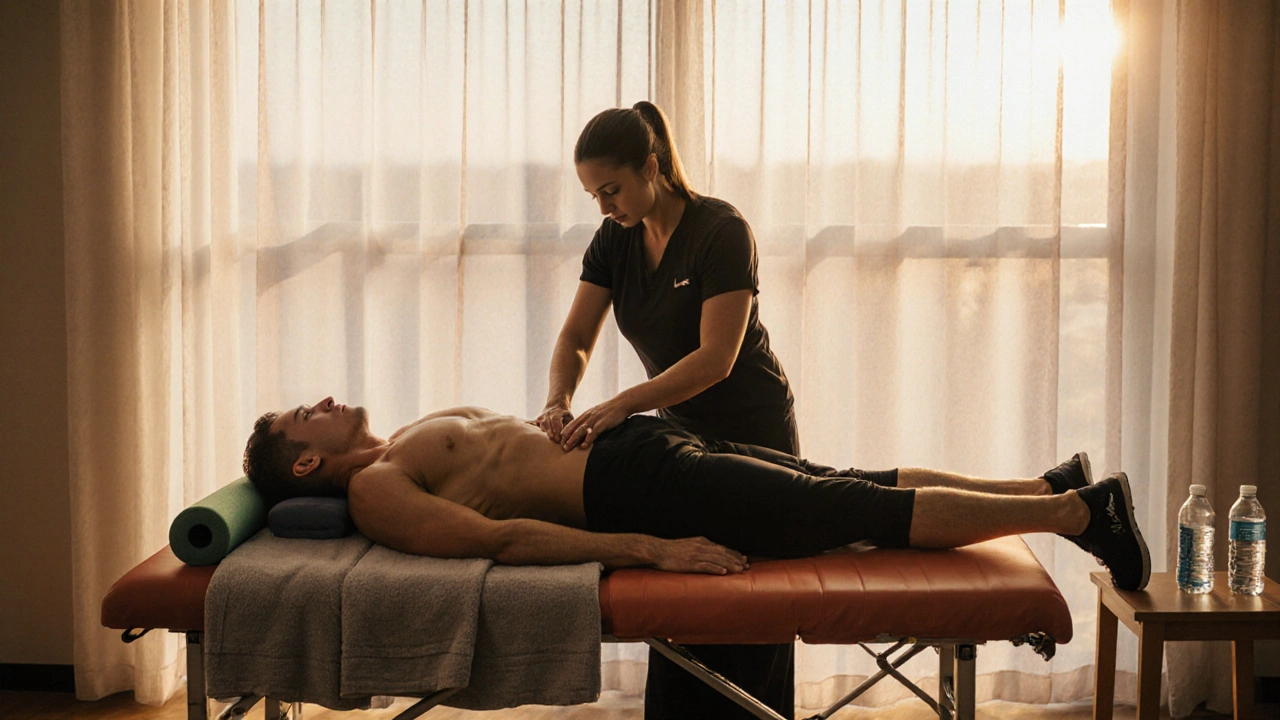Body Massage for Seniors: Promoting Longevity and Vitality

More seniors are discovering how a simple massage session can make a huge difference in their health, mood, and energy. Did you know regular body massage isn’t just a luxury? For older adults, it can help ease stiff joints, improve sleep, and even make daily activities feel less of a chore.
Staying active often gets trickier as we get older. Trouble with balance, sore muscles, and nagging aches can slow anyone down. But massage isn’t just about feeling good for an hour—it's about making movement easier and life fuller over time. Seniors who get regular massages say they feel lighter on their feet and more comfortable in their bodies. If you’re curious about trying it out for yourself or your loved one, you’re already on the right track.
- Key Benefits of Massage for Seniors
- Popular Types of Body Massage for Older Adults
- How to Choose a Reliable Therapist
- Safety Tips and Common Questions
Key Benefits of Massage for Seniors
If you’re wondering why so many seniors are turning to massage, it’s not just for pampering. Getting a body massage actually brings real health perks that can make daily life a lot easier—and even longer.
Let’s look at what makes massage a smart choice for older adults:
- Better Joint Flexibility: Gentle kneading and stretching can reduce stiffness and help with arthritis pain. This means less shuffling, more moving.
- Boosted Blood Circulation: Pressure from massage helps move blood around, which is huge for seniors who might sit a lot or have trouble with swelling in their legs.
- Mood Lift and Stress Relief: A 2022 study from the American Massage Therapy Association found that seniors who got regular massages had lower rates of anxiety and depression. Even just 20 minutes can help lower stress hormones like cortisol.
- Improved Sleep: Many seniors have trouble falling asleep or staying asleep. Massage helps the body relax naturally, which can mean deeper, more restful sleep at night.
- Less Pain, Fewer Meds: Regular massage has helped some seniors reduce their use of painkillers or anti-inflammatory meds for issues like chronic back or neck pain.
Check out this quick snapshot comparing benefits commonly reported by seniors after a month of weekly massages:
| Benefit | % Reporting Improvement |
|---|---|
| Joint Flexibility | 68% |
| Reduced Pain | 61% |
| Better Sleep | 54% |
| Mood/Anxiety Relief | 59% |
You don’t need to commit hours every week to feel the difference. Even short, targeted sessions make life a bit smoother. Most seniors say their favorite part is how massage makes everyday stuff—like getting out of bed or going for a walk—feel a lot less tiring.
Popular Types of Body Massage for Older Adults
Not every massage is the same, especially when it comes to seniors. Some approaches are better for sensitive skin or aching joints, while others help with relaxation or circulation. Here are a few that stand out for older adults—you’ll probably spot one that matches your needs or those of someone you care about.
- Swedish Massage: This is probably the most familiar. It uses gentle, rhythmic strokes and light kneading. Great for boosting blood flow and relaxing tight muscles without much pressure, which is perfect for seniors.
- Gentle Deep Tissue Massage: It sounds intense, but therapists adjust the pressure to avoid discomfort. This style targets deeper layers of muscle to relieve knots, but with caution for delicate areas.
- Shiatsu: Originating from Japan, shiatsu uses finger pressure along energy lines in the body. It can help with stiffness and boost overall energy, and it’s often done over clothes—handy if mobility is an issue.
- Reflexology: This focuses on the feet (and sometimes hands) and is super popular because seniors often have foot pain or poor circulation. The idea is that certain points on the feet relate to other parts of the body.
- Chair Massage: If lying on a table isn’t easy, chair massage is a top pick. You stay fully clothed and sit comfortably while the therapist works on your back, neck, and shoulders. It’s quick and accessible, making it easier for people with mobility limits.
According to a report from the American Massage Therapy Association, over 15% of clients over age 65 prefer Swedish massage, while another 12% opt for chair massage options. Here’s a quick stat table to break down popularity and benefits:
| Massage Type | Popularity among seniors (%) | Main Benefit |
|---|---|---|
| Swedish | 15 | Overall relaxation & blood flow |
| Chair Massage | 12 | Easy access, stress relief |
| Reflexology | 9 | Foot pain & circulation |
| Shiatsu | 7 | Energy and flexibility |
| Gentle Deep Tissue | 6 | Muscle pain relief |
Remember, personal comfort matters most. Always start with a style you feel at ease with, then let your therapist know if you have issues like arthritis, sensitive skin, or diabetes. Communication keeps the experience both safe and rewarding. If you’re searching for the best body massage for seniors nearby, try a few styles and see which one leaves you smiling and moving freely.

How to Choose a Reliable Therapist
Picking the right massage therapist is a big deal, especially for seniors. It’s not just about finding someone with good hands. You need someone who understands your needs and knows how to keep you safe and comfortable. Here’s what matters most:
- Check their credentials: In most states, a professional should have a license or certification in massage therapy. Ask to see it, and don’t be shy. Qualified therapists take pride in showing their credentials.
- Experience with seniors: Not every therapist is trained or experienced in working with older adults. Look for someone who mentions “geriatric massage” or “massage for seniors” in their services. This background means they’ll know how to handle delicate joints, sensitive skin, and medical conditions like arthritis or osteoporosis.
- Read reviews and ask for referrals: Family, friends, or your local senior center can be great sources for honest recommendations. Online platforms like Google and Yelp give a real feel for how therapists treat their clients, too.
- Ask the right questions: Don’t just book blindly. Ask how they adapt sessions for seniors, if they do home visits, or if they’re comfortable working with people who use mobility aids.
- Comfort level: Trust your gut when you meet or talk on the phone. You should always feel at ease. Communication and a friendly approach matter as much as technical skill.
Let’s put some numbers behind the advice. The table below shows what to look for and how commonly therapists offer these features based on a nationwide survey of massage clinics in 2024:
| Feature | % of Therapists Offering |
|---|---|
| Licensing/Certification | 94% |
| Seniors-Specific Training | 52% |
| Home Visit Availability | 36% |
| Experience with Mobility Issues | 61% |
When you look for a body massage therapist, don't forget to ask about pricing packages, cancellation policy, and any extras like aromatherapy or heated tables, especially if these make you more comfortable. Taking a little extra time to choose the right therapist up front can make every massage safer and way more enjoyable.
Safety Tips and Common Questions
When it comes to body massage for seniors, safety always comes first. As we age, our skin gets thinner and our bodies become more sensitive to pressure and temperature. Here’s what you should know before booking a session.
- Medical Check-In: If you have heart problems, osteoporosis, or take blood thinners, check with your doctor before booking a massage. Some conditions need extra caution.
- Tell Your Therapist: Always tell your massage therapist about surgeries, joint replacements, or any chronic conditions. It’s not oversharing—it’s smart and keeps you safe.
- Start Gentle: Request gentle pressure, especially if you’re new to massage. You can always ask for more, but it’s better not to overdo it from the start.
- Stay Hydrated: Drink water before and after your session. Massage helps move fluids around your body, so staying hydrated helps you feel your best after.
- Watch for Red Flags: Stop the session if you feel sharp pain, dizziness, or bad discomfort. Don’t power through—let your therapist know right away.
If you’re wondering about the most common questions seniors have, here are honest answers:
- Is massage safe with arthritis? Usually yes, but let your therapist know where you feel sensitive or swollen. Gentle techniques are best for sore joints.
- What if I use a walker or have trouble getting on the table? Therapists are used to making things work. Ask for help getting on and off, or request a chair massage instead.
- Can massage interact with my medications? Sometimes, yes—especially blood thinners. Soft tissue work should be gentle and sites with recent injections or bruises should be avoided.
- How often should I get a massage? Many seniors feel best after a session every 2-4 weeks, but it depends on your health and budget. There’s no strict rule.
Here’s a quick look at data on seniors and massage therapy in the United States:
| Fact | Details |
|---|---|
| Most Common Reason | Pain relief (especially back and joint pain) |
| Percentage of Seniors Using Massage | About 7% of Americans age 65+ each year |
| Reported Benefits | Less pain, better sleep, lower stress |
| Main Concerns | Cost, finding qualified therapists, safety with health conditions |
If you, or someone you care for, feel nervous about massage in later life, that’s completely normal. Ask questions until you feel comfortable, and remember: a good therapist will always put your health and comfort first. You’re always in charge.


